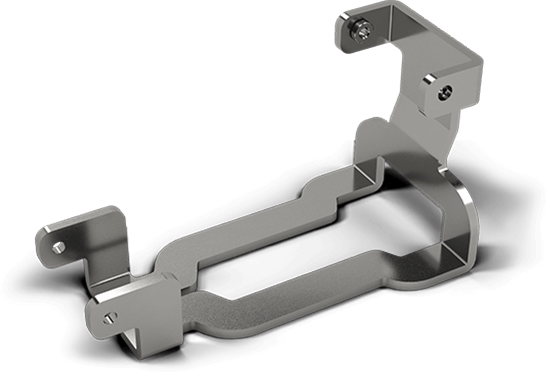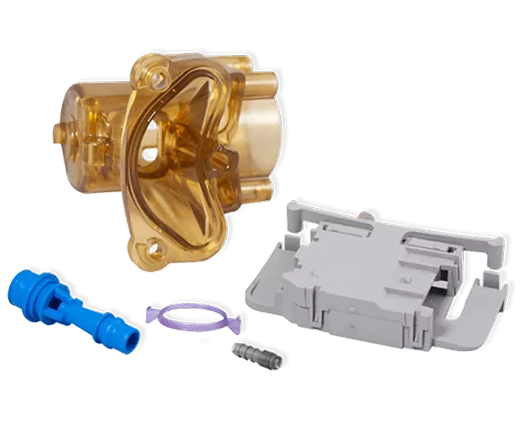Overmolding Service
Manufacture parts with multi-shot thermoplastic injections for enhanced consistency, strength,
and durability in high volume projects.

What is Overmolding?
Overmolding is an injection molding process in which multiple shots of thermoplastic are injected separately to create a single part. The first thermoplastic injection into a tool or cavity forms a substrate, before an overmolding material is injected into, onto, or around it. The thermoplastic layers bond as they cool to produce a unified and highly durable final product. The bond between substrates depends on the properties of the relevant overmolding materials. Learn more about the bonding process with our material compatibility chart.
Overmolding is ideal for high-volume production runs. Kickstarting your injection molding project is simple. Upload your CAD file to the Fast Radius Cloud Manufacturing Platform™, optimize your design and choose your desired thermoplastic, and then greenlight production with the click of a button.

Overmolding Applications
Overmolding is used to produce customized parts and components for a variety of applications:
Niche Manufacturing
The overmolding process is useful for the manufacture of niche, durable parts, including gaskets, filters, and brackets. Overmolding is also suitable for functional prototyping.
High-volume Production
Overmolding produces consistent parts quickly with low tooling costs, and is ideal for projects with high volume production requirements.
Niche Manufacturing
The overmolding process is useful for the manufacture of niche, durable parts, including gaskets, filters, and brackets. Overmolding is also suitable for functional prototyping.
High-volume Production
Overmolding produces consistent parts quickly with low tooling costs, and is ideal for projects with high volume production requirements.
Overmolding General Process Information
Substrate wall thickness
- The thickness of the substrate’s wall determines how effectively the overmold material flows in, on, and around the substrate. Due to temperature differences between substrate and overmold materials, having an inconsistent wall thickness can lead to warping, increase flash, and render fills incomplete.
- Ensure that the wall thickness of the substrate and thickness of the overmold are even and consistent from the beginning of the process. Wall thicknesses ranging from 0.060″ to 0.120” (1.5 mm-3 mm) will ensure good bonding in most overmolding applications.
Maximum part size
800 x 800 x 400 mm
31.5 x 31.5 x 15.7 in
31.5 x 31.5 x 15.7 in
Substrate wall thickness
The thickness of the substrate’s wall determines how effectively the overmold material flows in, on, and around the substrate. Due to temperature differences between substrate and overmold materials, having an inconsistent wall thickness can lead to warping, increase flash, and render fills incomplete.
Ensure that the wall thickness of the substrate and thickness of the overmold are even and consistent from the beginning of the process. Wall thicknesses ranging from 0.060″ to 0.120” (1.5 mm-3 mm) will ensure good bonding in most overmolding applications.
Ensure that the wall thickness of the substrate and thickness of the overmold are even and consistent from the beginning of the process. Wall thicknesses ranging from 0.060″ to 0.120” (1.5 mm-3 mm) will ensure good bonding in most overmolding applications.
Overmolding Materials
Most common materials
- Acrylonitrile Butadiene Styrene (ABS)
- Polyethylene (PE)
- Polypropylene (PP)
- Polycarbonate (PC)
Other supported materials
- Nylon (PA 6, PA66, PA 12)
- Polycarbonate/Acrylonitrile Butadiene Styrene (PC/ABS)
- Polyurethane (PU)
- Polymethyl Methacrylate (PMMA/Acrylic)
- High Density Polyethylene (HDPE)
- Low Density Polyethylene (LDPE)
- Polystyrene (PS)
- Polyvinyl chloride (PVC)
- PEEK
POM (Acetal/Delrin) - Polyethylene Terephthalate (PET)
- Thermoplastic Elastomer (TPE)
- Thermoplastic Vulcanizate (TPV)
- Polyetherimide (PEI)
- Polysulfone (PSU)
Inquire for additional options
Most common materials
- UV absorbers
- Flame retardants
- Plasticizers
- Colorants
- Glass fibers
Overmolding colors, Finishing, Post-processing
Colors
Finishing and post-processing options
- Pantone color matching
- RAL color matching
- Standard SPI finishes (A2-D3)
- Mold-tech textures also available
- Pad printing
Inserts (e.g. heat stake inserts) - Light assembly
Protective packaging / film
Why Choose Overmolding?
Overmolding produces strong, long-lasting parts for improved component reliability. Explore the key benefits and challenges of the process:
Benefits
- Strong, durable parts
- High consistency and precision
- Customization potential
- Cosmetic finishing options
- Create safe, comfortable parts for customer end-use

Challenges
- Requirement to check compatibility between thermoplastic materials
- Precision set-up required to prevent fractures.
- Requires 2 mold cavities to produce the substrate and the overmold
- Upfront design and tooling costs

Put your parts into production today
-q4gvl4k29y4hq8j9rjpapvj0ft06fje63olt7p210i.png)